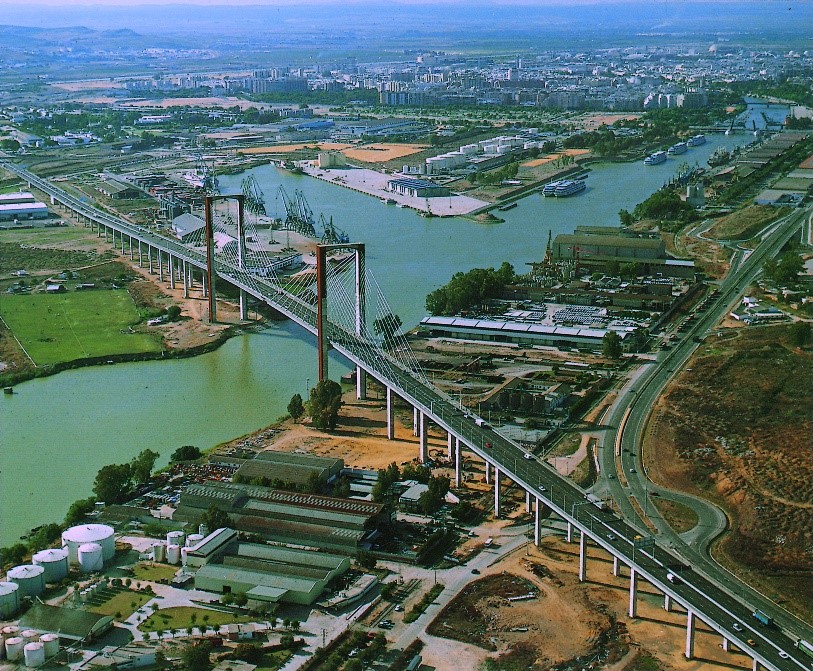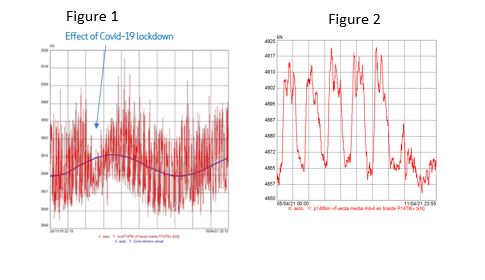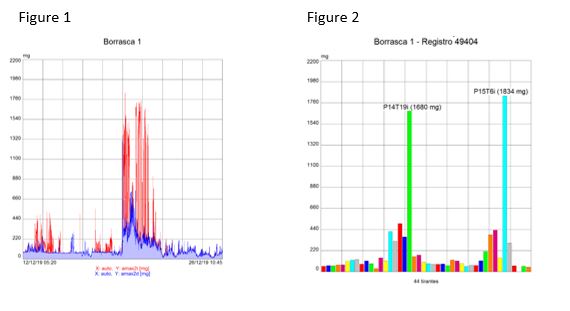Centenario Bridge (case study)
The monitoring system has returned the main following findings:
- The cables forces have a daily cycle oscillation due to traffic and an annual cycle due to temperature, both within the expected range. There has been no drift in their value that can be attributable to corrosion.
- A phenomenon that had not been observed before on the bridge has been detected: several episodes of very high vibrations (> 2g) caused by the combined wind-rain effect have been recorded."
Object description
The Centenario Bridge is cable-stayed in Seville, Spain. It was built in 1991 and has an average daily traffic of over 100.000 vehicles. It has five spans of 48 m, 102 m, 265 m, 102 m, and 48 m. Each pylon is composed of two columns of 6 × 4.5 × 102 m, separated by 26.5 m. It has 88 stay cables of lengths between 25 and 145 m.
Object analysis
"The solution adopted to know the force of the stay cables at any moment is based on dynamic instrumentation with accelerometers. The total amount of sensors is 120. In addition to other complementary sensors, each of the 88 cables has an accelerometer continuously monitored at a rate of 100 readings per second. A volume of 900 million data is generated daily. With this amount of data, two parallel processes are carried out in real-time:
- Statistical analysis, which provides the minimum, average, maximum, and RMS acceleration levels in intervals of 3 seconds (short span) and 10 minutes (long span).
- Spectral analysis, which provides the main vibration frequency of each stay cable (and, immediately, the force) obtained from the application of the FFT (Fast Fourier Transform) together with a special algorithm developed for this purpose.
Both processes take place at the bridge, automatically and without any human intervention.
The measured values of the cable forces feed the structural model of the bridge, allowing decision making."
Object state
"In 2018, a campaign was carried out to assess the structural health of the bridge. Due to the signs of corrosion in the anchors and other deteriorations found, it was decided to proceed with the replacement of the stay cables. However, the time required to develop the replacement project, contract, and undertake the replacement (keeping traffic on the bridge) was estimated to be over 3 years. As the bridge is a critical infrastructure and the traffic level is very high, the decision was made to install a real-time structural remote monitoring system on the bridge, mainly focused on the 88 cable forces. The monitoring system has returned the main following findings:
- The cables forces have a daily cycle oscillation due to traffic and an annual cycle due to temperature, both within the expected range. There has been no drift in their value that can be attributable to corrosion
- A phenomenon that had not been observed before on the bridge has been detected: several episodes of very high vibrations (> 2g) caused by the combined wind-rain effect have been recorded."
Images
Documents
This case study was contributed by Silvia de la Orden of . Last edited by technical staff.



